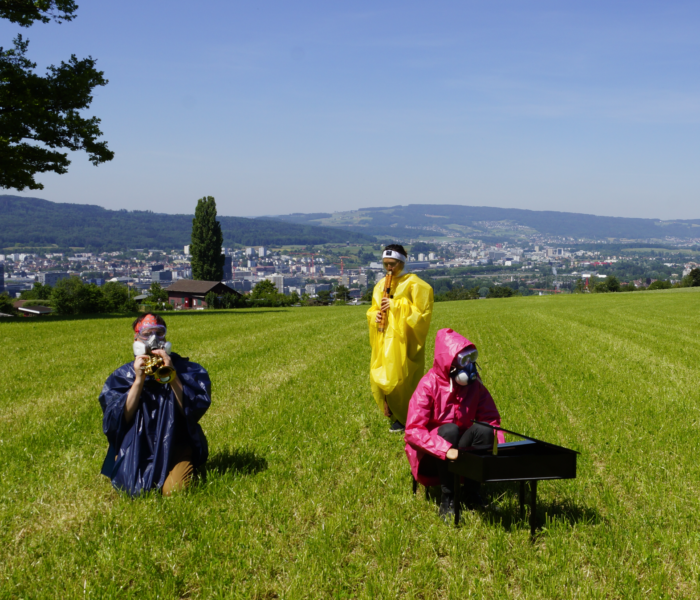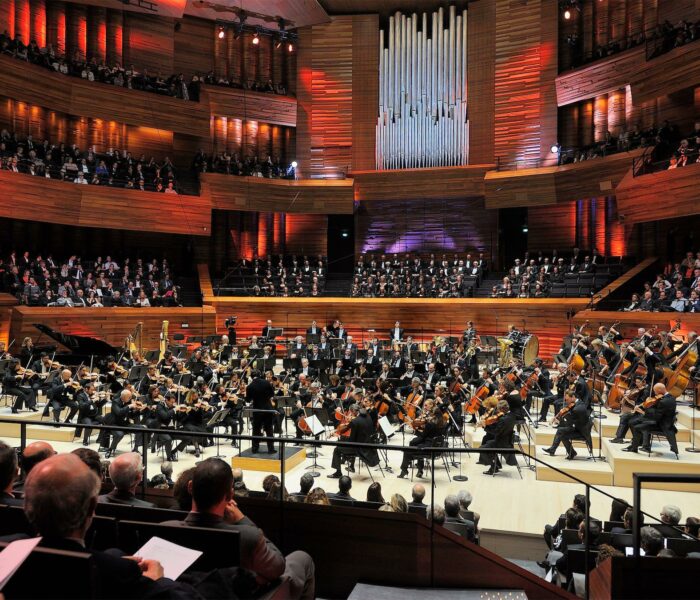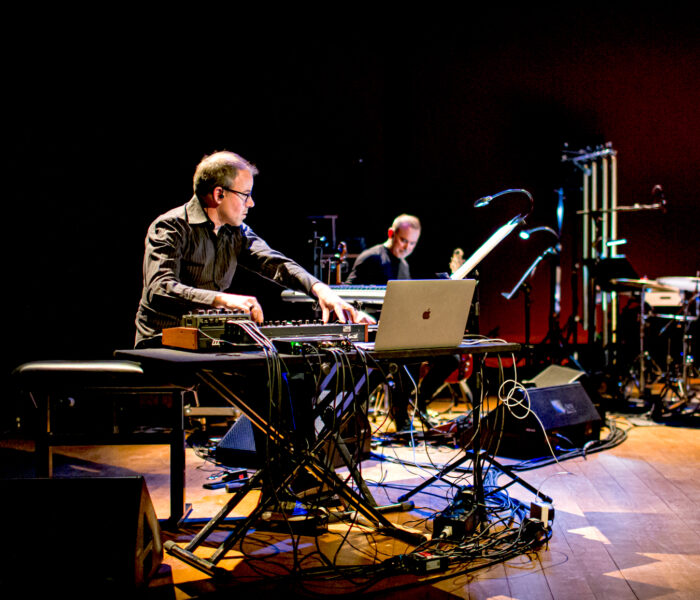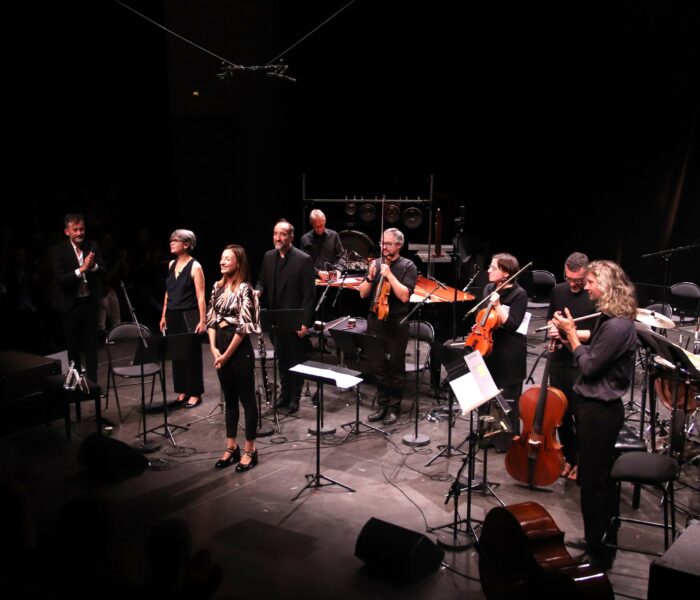Plongé dans les entrailles de l’Ircam avec le son immersif de l’Espro ou de plein pied dans la Galerie 3 du Centre Pompidou, avec vue sur le monde extérieur, le festival ManiFeste 2023 accueille la clameur du monde et célèbre la réunion des arts, de la musique et de la technologie.
Présents et vigilants
Un drapeau noir mis en mouvement par les danseurs qui se relaient, flotte au-dessus du plateau dans l’attente du spectacle… Avec la chorégraphe Ula Sickle, l’ensemble belge Ictus a investi la galerie 3 du centre Pompidou pour donner Holding Présent, une nouvelle proposition scénique où s’interpénètrent les gestes des musiciens et des danseurs dans un espace collectif et une communauté de mouvements.
Décloisonner les pratiques, inventer de nouveaux formats de concert et dispositifs d’écoute (sa série des Liquid rooms) et rencontrer d’autres expressions artistiques, comme la danse avec laquelle il multiplie les collaborations depuis 1994 : voilà l’ADN de l’ensemble belge Ictus, un des acteurs principaux des « scènes ouvertes » qui signe sa première collaboration avec Ula Sickle. Musiciens et danseurs sont les invités pour six représentations de Moviment (la manifestation du Centre Pompidou où les arts visuels se mêlent au cinéma, à la performance, à la musique, à la parole…) et du festival ManiFeste de l’Ircam.
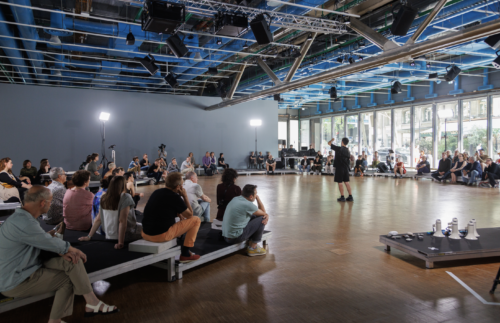
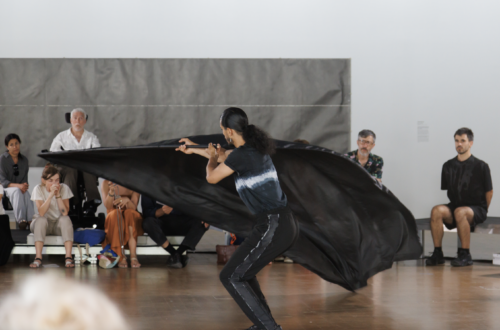
Le public est assis sur les praticables qui cernent l’espace en ellipse de la scène, à hauteur des quatre musiciens d’Ictus (flûte, percussion, clavier, guitare électrique) qui ne font pas que jouer de leur instrument, s’aventurant le plus souvent sur le plateau pour y manipuler des objets sonores et y danser. Une couronne de haut-parleurs et des panneaux Led sur le pourtour de la salle assurent la diffusion sonore (Sylvain Cadars de l’Ircam) et la dramaturgie lumières (Ofer Smilansky). Des textes et une dizaine de séquences musicales s’enchaînent, œuvres répertoriées de compositeur·trices des quarante dernières années (dont la forme ouverte laisse une certaine latitude aux interprètes) ainsi que des improvisations et une œuvre en création, Music for Holding Present, commande passée à la compositrice turque Didem Coskunseven qui est dans les rangs du public. Participant à la chorégraphie et au continuum sonore, musiciens et danseurs sont souvent confondus, l’instrumentarium déployé ne requérant pas toujours l’expertise du professionnel. Ainsi les tubes d’aluminium de l’artiste sonore Gert Aersten que l’on fait résonner avec le doigt ; et si Ruben Martinez Orio alerte les oreilles avec son triangle amplifié (pièce fétiche d’Alvin Lucier) au début de la performance, il est entouré de ses partenaires musiciens et danseurs lorsque résonne plus intensément encore la version du même Lucier pour quatre triangles. Des pierres sont entrechoquées par l’ensemble de la troupe dans Rock Piece de Pauline Oliveros, donnant l’illusion d’un lithophone géant. On est sidéré de découvrir au bout d’une heure de spectacle que la « danseuse » au costume rouge qui a participé au mouvement chorégraphique depuis le début, n’est autre que la pianiste d’Ictus!
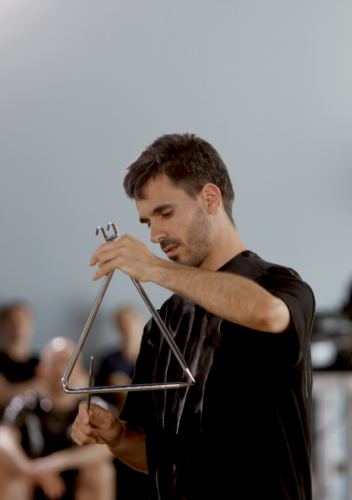
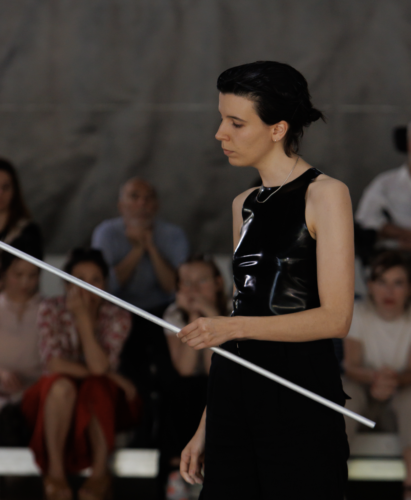
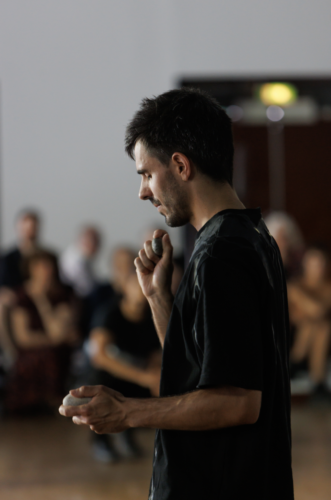
On adhère immédiatement à la chorégraphie d’Ula Sickle, aux gestes clairs autant que puissants qui nous parlent de résistance, de soulèvement et de combat : bras levés, mains ouvertes, poings croisés, tête esquivant les coups : des gestes qui se reproduisent d’un danseur à l’autre, quasi en canon, tandis que le mouvement devient collectif jusqu’au climax d’intensité et de ferveur porté par l’ensemble des participants. Amanda Barrio Charmelo et Mohamed Toukabri, tuniques et pantalon noires, baskets montantes souples (comme le reste de la troupe) dansent en duo, moment de chorégraphie au sol plus intimiste et d’une grande fluidité durant l’improvisation des musiciens situés sur le pourtour du plateau. Ils sont également à leur poste pour l’exécution de A giant Blowing machine or a pocket tin sandwich du compositeur, performer et violoncelliste sarde basé à Berlin Stellan Veloce. Les instruments ici convoqués sont les harmonicas puis les mégaphones qui amplifient les harmonicas, réactivant l’idée du collectif et de la contestation.
La pièce de Didem Coskunseven est scindée en trois séquences alternant avec d’autres propositions sonores. La première, très impressionnante par les masses sonores qu’elle charrie, est pour synthétiseur modulaire ; la seconde est plus lunaire et poétique, où la guitare électrique de Tom Pauwels rejoint l’univers du synthétiseur. La dernière intervention, d’une vingtaine de minutes, articule deux sections : une partie électroacoustique ouvrant un espace démultiplié, tsunami de sons habité de souffle, de déferlements bruiteux et d’appels ; avant la réunion des cinq musiciens dans un final aux sonorités plus lumineuses et au balancement doux, qui met en vedette la guitare électrique.
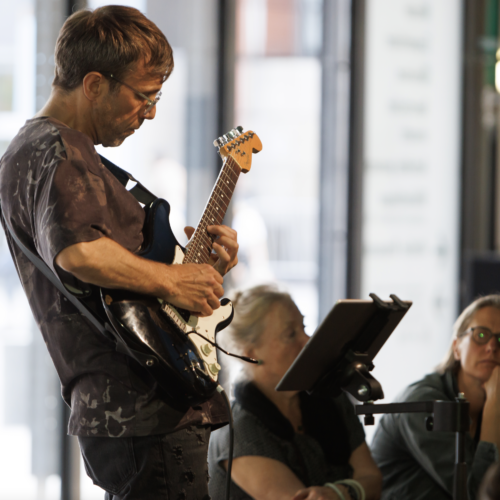
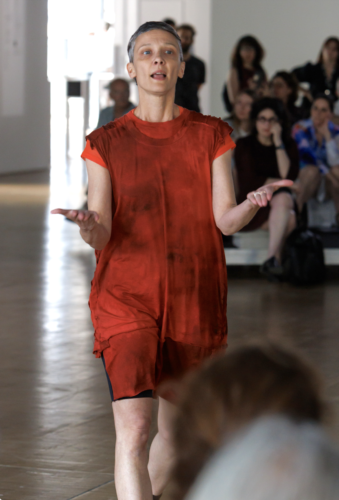
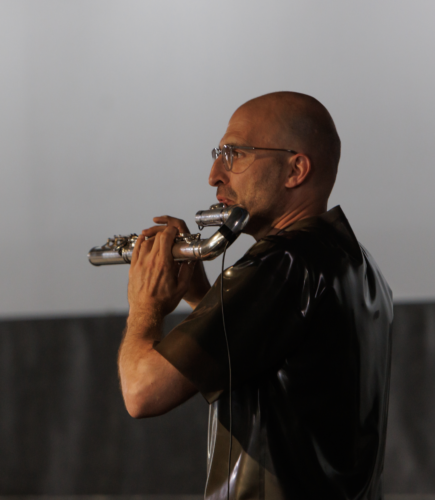
Le rhombe que fait tourner in fine le danseur, où s’éternise la permanence du souffle, rappelle le tournoiement du drapeau noir en silence, symbole du geste individuel (Holding Présent) qui s’élève à la puissance d’une action collective.
Composer le son à l’Espace de projection
Réouvert en janvier dernier, l’Espro de l’Ircam est sans aucun doute le lieu inouï en matière d’acoustique, un espace modulable qui accueille les expériences sonores et autres performances technologiques, dans des conditions d’écoute optimales. Quatre pièces et autant de configurations spatiales sollicitant l’électronique sont à l’affiche d’un concert où musique et art-science se confrontent et s’interpellent.
Tout à la fois compositeur-chercheur et réalisateur en informatique musicale (une double casquette qu’il revêt durant la soirée), José Miguel Fernandez est aux manettes pour Embeddind Tangles (2013), pierre d’angle du répertoire pour flûte et électronique en temps réel de la compositrice Lara Morciano. Seule en scène, Anne Cartel nous impressionne, déployant énergie et virtuosité dans une pièce aux figures polymorphes, pensée en fonction de sa projection dans l’espace.

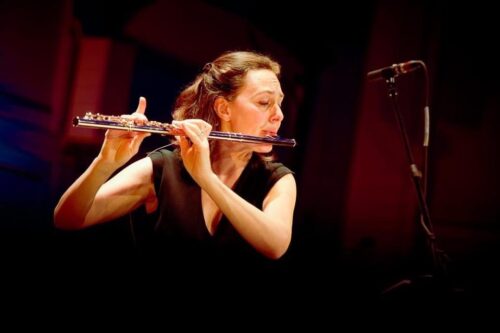
Luciano Berio est fêté cette année à ManiFeste (les 20 ans de sa mort avant le centenaire de sa naissance en 2025). Après Laborinthus II qui ouvrait le festival, c’est Thema, Omaggio a Joyce (1958) pour bande magnétique que l’on entend à travers le dispositif d’écoute de l’Espro. L’œuvre débute par la voix de Cathy Berberian qui lit le texte de Joyce (onzième chapitre d’Ulysse). Le document d’archive est touchant. Le son de la bande est d’époque et les manipulations de studio également : fragmentation du texte, mixage, montage et filtrage. La version multicanale donne une nouvelle vie à cette pièce historique où Berio célèbre la voix féminine qui sort des haut-parleurs.
Tout jeune compositeur italien remarqué lors du concert du Cursus en 2021, Matteo Gualandi écrit le texte (en italien, anglais et français) et la musique de ses Fiori di sangue e rugiada (2023), 14 pages de journal intime pour mezzo-soprano, violon, violoncelle et électronique dont neuf sont données ce soir. Trois visions poétiques s’y succèdent. Violon (Alexandra Greffin-Klein) et violoncelle (Clotilde Lacroix) sont de part et d’autre de la chanteuse (Stéphanie Guerin très hiératique) : le dispositif est sobre, les cordes au plus près du texte (l’accord change à la deuxième vision) et la partie électronique au service de la traduction poétique, fusionnant souvent avec la voix. On est saisi par la radicalité de l’écriture instrumentale et la stylisation du chant, murmuré, haché ou d’un lyrisme éperdu. Chacune des fleurs qui scandent les pages du journal (fiore primo, secondo, terzo) s’accompagne du bruit de la pluie, comme un doux refrain. La troisième vision, ramenant la texture délicate des cordes dans un temps et un chant très étiré, est d’une sublime beauté.
GALERIE 2
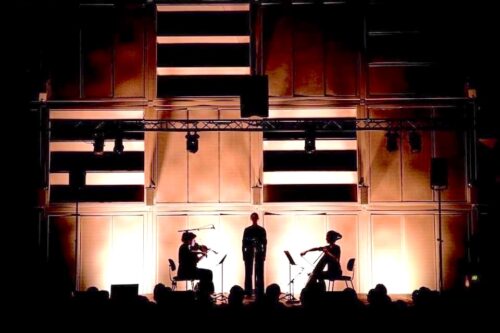
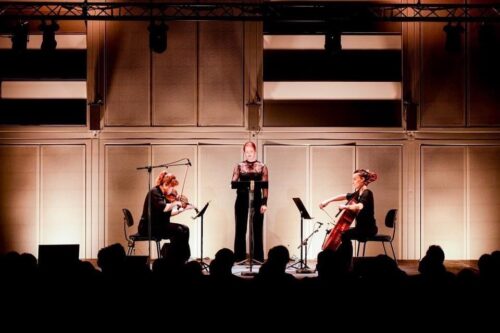
Virtuose du temps réel sur lequel il axe toute sa recherche, José Miguel Fernandez a pensé sa nouvelle œuvre, Sources rayonnantes, pour l’Espro et à travers ce qu’il nomme « une orchestration de l’espace ». Les douze musiciens de l’ensemble Court-Circuit sont installés sur le pourtour de la salle. Le chef Jean Deroyer fait face au public, en charge de la direction et responsable de l’ingénierie électronique via ce gant noir qu’il porte à la main droite. Il est muni d’un capteur qui permet à l’ordinateur, dans un premier temps, de reconnaître la battue du chef, à l’aune d’un enregistrement de gestes réalisé au préalable, puis d’enclencher les processus de l’électronique en temps réel : « une action et des développements qui s’avèrent parfois plus élaborés que l’écriture instrumentale », souligne le compositeur qui contrôle les opérations à la console, au côté du RIM Serge Lemouton. Le résultat obtenu et entendu est spectaculaire, ludique autant que sauvage, réalisant ce continuum recherché entre la source instrumentale et sa propagation dans l’espace, son rayonnement en termes de trajectoires ascensionnelles et de couches de synthèse qui se superposent. La constellation sonore est inouïe, dont on perçoit ce soir tout à la fois l’intensité élémentaire et rude et l’élan puissant et jubilatoire.
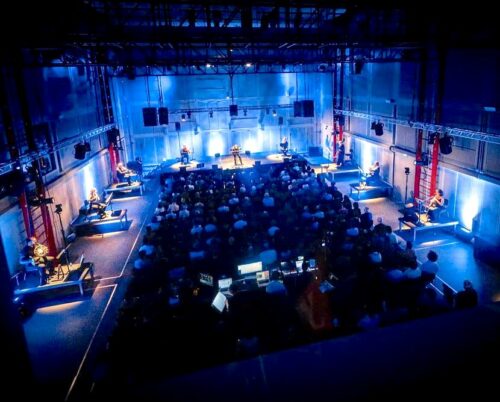
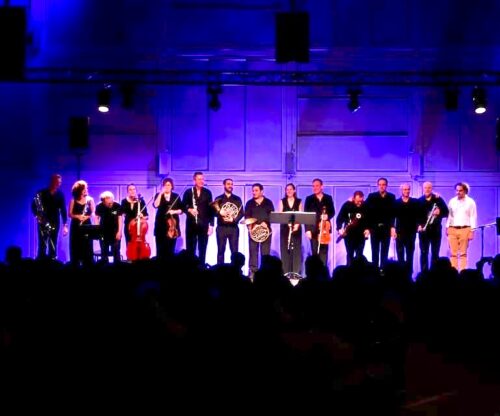

Michèle Tosi
ManiFeste, Centre Pompidou, Paris – 16-06-2023
Holding Present, spectacle performance ; Ula Sickle, concept chorégraphie ; Tom Pauwels (Ictus), concept, direction musicale. Alvin Lucier, Pauline Oliveros, Stellan Veloce, Didem Coskunseven (CM), composition ; Augustin Muller, électronique Ircam (pour Didem Coskunseven) ; Sylvain Cadars, diffusion sonore Ircam : Gert Aertsen, instruments originaux ; Amanda Barrio Charmelo, Marina Delicado, Marie Goudot, Ruben Martinez Orio, Michael Schmid, Mohamed Toukabri, Tom Pauwels, Ula Sickle, création et performance ; Ofer Smilansky, éclairages et sonorisation ; Richard Venlet, scénographie; Wang Consulting, costumes.ManiFeste, Espace de projection Ircam, Paris – 17-06-2023
Anyway avec Lara Morciano (née en 1968) : Embedding Tangles pour flûte et électronique ; Luciano Berio (1925-2003) : Thema, Omaggio a Joyce, pour bande magnétique ; Matteo Gualandi (né en 1995) : Fiori di sangue e rugiada, pour mezzo-soprano, violon, violoncelle et électronique ; José Miguel Fernández (né en 1973) : Sources rayonnantes, pour 12 instruments et électronique (CM). Stéphanie Guérin, mezzo-soprano ; Anne Cartel, flûte ; Alexandra Greffin-Klein,
Photos © Hervé Veronèse
Photos © Quentin Chevrier
Photos © Gary Gorizian



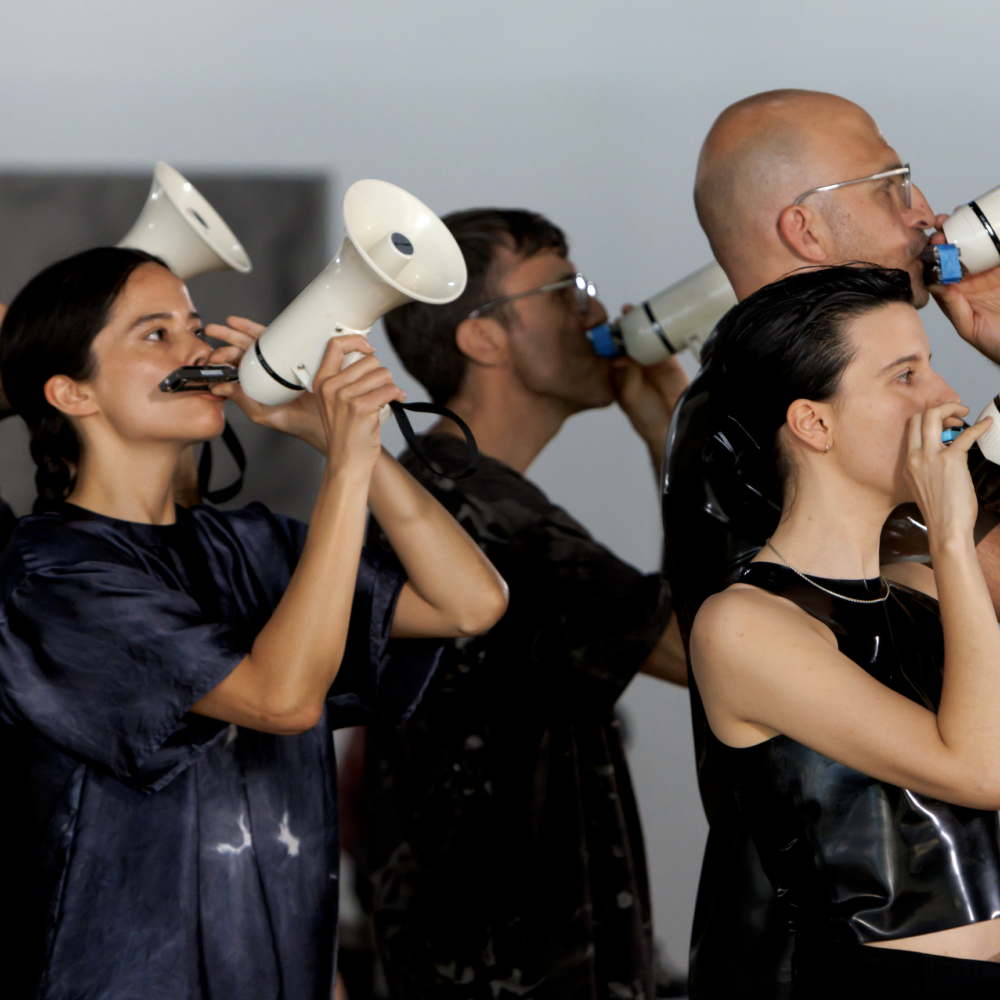)
